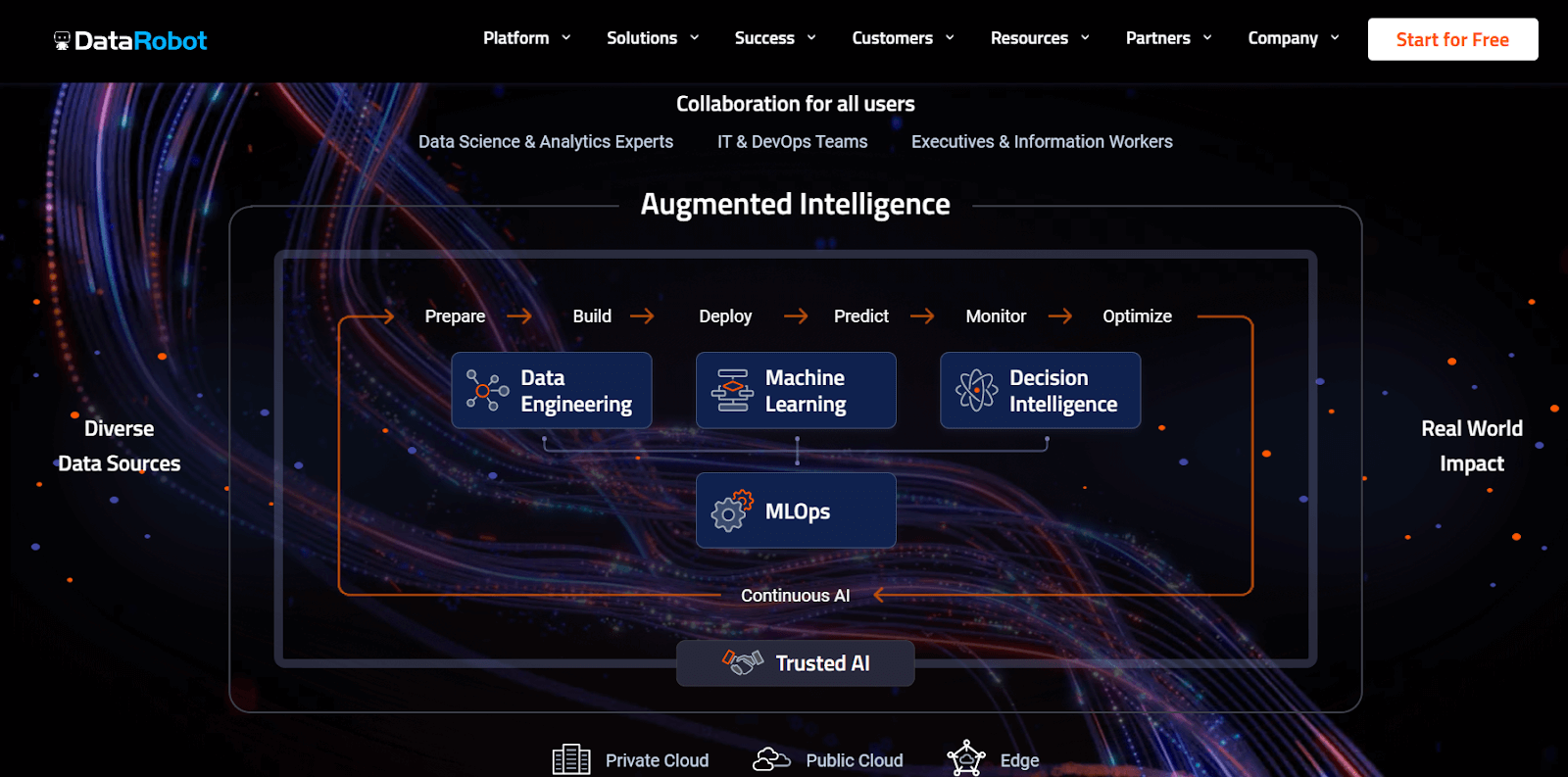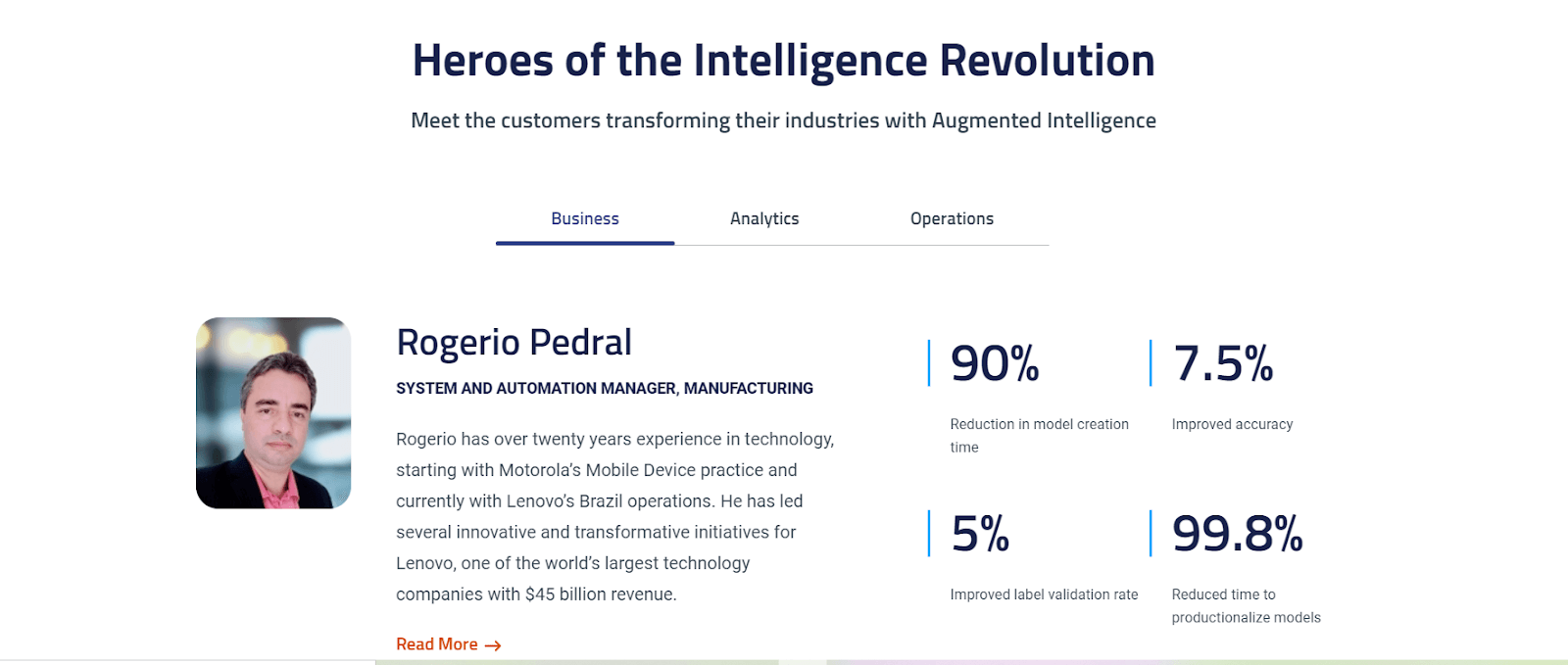What TrustRadius Research Says
DataRobot Pricing 2022
Artificial Intelligence platforms are becoming a popular B2B product, with its ability to automate, analyze, and increase productivity. Through machine learning and deep learning, AI platforms can perceive powerful insights for almost any business.
DataRobot’s Artificial Intelligence (AI) Cloud Platform is for predictive analytics and predictive analysis. It’s used by data scientists, data analysts, and business analysts. You don’t have to be a programmer to use the software, but you should have some kind of analysis background.
What is DataRobot?
DataRobot is an AI Cloud platform for augmented intelligence. There are 4 main uses: data engineering, machine learning, decision intelligence, and Machine Learning Operations (MLOps). It is an incredibly powerful software-as-a service (SaaS) for developers and data scientists.
DataRobot is frequently used by small businesses, but that’s not a rule. Healthcare organizations, government and educational institutions use them along with larger corporations like Kroger. They have an entire section that covers some of the variety of services they can offer businesses as well.
Some of the industries include some you don’t automatically associate with AI Clouds, including the Oil and Gas market and sports. In the industries section you will find examples of how AI software can help you and your employees.
DataRobot outlines their main demographics as Data Scientists, Business Analytics, Software Engineers, Information Technology (IT) Operations, and Executives and Information Workers. They have separate product models for those different users.

If you’re new to these concepts, augmented intelligence is people predicting human behavior patterns with AI. The behavior could be shopping, voting, or general demographic interests. The insight provided by an AI cloud platform helps businesses develop new strategies for growth.
You can use the AI Cloud for predictive analytics and predictive analysis, automation of tasks, automated feature engineering, and more. Automated feature engineering is an important aspect of the data science life cycle, and can be the key to how successful your AI endeavors are. It’s a core part that DataRobot takes the care to help you succeed. For more information see their page dedicated to the process.
The platform also has tools specifically designed for ease of use so you can deploy, run, and create. These tools include a metrics pane to monitor model performance, and data visualization tools for visual AI.
DataRobot notes the success of what their customers have done with access to their Cloud AI. One data scientist for a retail company used DataRobot AI to engage with customers. An analyst at a healthcare company used DataRobot to create dashboards so other employees could use the platform and streamline workflows.
One of DataRobot’s goals is to democratize AI and make it accessible to non-data scientists. However, some experience in data analysis is needed to use the software. You will see that many of their satisfied users or “AI heroes” are analysts or data scientists. Their successful projects are more about other people’s access to the information generated with the platform. You can read more about their “AI Heroes” here, and see DataRobot reviews on our website.

DataRobot offers customers their AI Cloud in three different ways. Their On-Premise AI Cluster, Private AI Cloud, and Hybrid AI Cloud. The on-premise option is meant to offer more security, especially for those that need to be HIPAA compliant. The cluster allows you to store information on your own server. The private cloud allows you to to store it on other clouds, like Amazon Web Services or Microsoft Azure. The hybrid allows users to utilize on-premise and cloud deployments together.
DataRobot’s infrastructure is well suited for integrations. To start with, most of the infrastructure they use is from the most popular open-source AI tools like TensorFlow, and Python scikit-learn. When platforms are open-source, it makes it easier This also makes it possible to interact with the AI Cloud in a programming environment.
Some of the integrations you can choose are Google Cloud Storage, Microsoft SQL Server, and Amazon s3 (another storage option). DataRobot also has partnerships with other software companies including AWS and Alteryx.
New to Data Analytics?
It’s important to know that DataRobot’s website is rich with programming and analytics terms, and if you aren’t experienced it’s better to consult with the member of your team who is. DataRobots actual users are experienced with data analytics. The software is designed for people with that kind of background information.
In order to ease some of the initial learning curve, DataRobot has exciting media to check out if you’re new to AI, and MLOps, or just want to see how their software works. These resources can be particularly helpful for students.
DataRobot has a MLOps 101 explanation page, a Trusted AI 101 page, and AI and Machine Learning in 20 Minutes. These pages have resources and definitions of the concepts, but they also go further to explain how they can advance your business and why you should consider them.
If you do have questions about the software you can go to the community forum of DataRobot. There you can see discussion, news and resources concerning the software. There is also their Resource Library, wiki, blog, and you can always contact them. Here is DataRobot’s demo video explaining what the product does and how it works.
DataRobot Pricing information
DataRobot offers customized solutions to their customers, so to obtain an estimate or demo, contact DataRobot’s team. With that said, there are a number of important features related to pricing like product solutions, and discounts for academia or public institutions
First things first, DataRobot offers a comprehensive free trial where you can interact with the software. The DataRobot AI Cloud Platform Free Trial requires you to make an account. The pricing formats DataRobot offers are either the Hosted Enterprise Cloud Version or the Credit version. The Enterprise plan is not based on credits and billed more directly.
The free trial is based on credits. You will need credits to run everything and when you run out of credits it becomes read only. You will be told your amount of credits, after signing up and filling out the specifications of your project goals, in a confirmation email. If you want to buy more credits this post explains Credit Allocation and Purchasing.
DataRobot’s free trial also has several limitations. These limits include, but are not limited to: no exports, no support (but community support is available), limited users (undisclosed cap), and no sharing. For the full specifications, see this post detailing the free trial. There you will find answers to whether you can use Python or R languages (yes!), and API resources.
When you are ready to consider buying DataRobot, you will want to look at the Buying FAQs page. There you will also find the discounts DataRobot offers. For the chance to receive a discount, you’re required to fill out applications. The discount amount is not disclosed before your application is reviewed and accepted.
Discounts are available for academic institutions, government agencies, and nonprofits. DataRobot does this to help make AI more available to sectors that really need it. Beyond this, it's mutually beneficial for universities to use DataRobot’s AI platform for algorithm and automated machine learning. Teaching their AI Cloud can make the platform an industry standard, and train future employees at the same time.
Government agencies may benefit from predictive models and data analytics that allow them to make more informed decisions for future programs or initiatives. For example, the predicted human behavior response to a pandemic.
DataRobot is not the only AI and machine learning platform, and there are plenty of alternatives. We go over some fantastic options.
DataRobot Alternatives
When it comes to pricing for AI Cloud’s it's not easy to actually find clear pricing. The giants of Google Cloud AI, Amazon Web Services Sagemaker, and Microsoft Azure Machine Learning have intricate pricing details.
They will charge you based on use and if your use runs into other services. That is a very easy catch because those clouds have ingrained services, so there may easily be something else you need to use from another program, leading to unforeseen costs.
We’re not playing with that headache here; we’re going open source. There’s nothing wrong with paid services and if you’re interested in Amazon Sagemaker, Azure Machine Learning, you’re welcome to read through their pricing pages.
Some of the open-source alternatives we’re going to speed through you may recognize. Some are developed by major software companies like AWS, and some were used by DataRobot for their infrastructure. These open source options are Amazon Sagemaker Neo, H20.ai, and TensorFlow.
Open-source Software | |||
Defining Feature | Fully Compatible with AWS | Compatible with H20 Cloud | TensorFlow Resource Library |
Amazon Sagemaker Neo is available as an open source software through an Apache Software License, but you do still need to make an AWS account. The software lets you build machine learning models, and then train them to make predictions. You can deploy the models on AWS or edge devices. You will need to watch for any related AWS applications if you deploy on AWS. The costs can add up without you realizing.
One of DataRobot’s closest competitors is H20 AI Cloud. They are both cloud applications that offer the same AI solutions. One big difference is H20 offers H20.ai as a completely open source AI product.
It can run on the big data infrastructure of an enterprise or virtually on Kubernetes or Spark clusters. If you are a startup that wants to get a jump about the rest and revolutionize your workforce, this is the more budget conscious option.
TensorFlow is a machine learning platform with a famously extensive library to help you develop and train models. The software was developed by Google before it was made open source. It’s an open source platform so common, intuitive, and powerful that Coca Cola, Google, Intel and Twitter.
For more alternatives to DataRobot check out our listed competitors with customer reviews.
More Resources
If you want to learn more about DataRobot visit their Resource Library. If you want to see a project in action, we have the perfect video here. This video teaches DataRobot AI to complete and total beginners. It can be a helpful crash course if you are a student or an experienced developer. It’s a great way to see the UI.
Those of you that want to see more AI Operations AIOps tools, can see our product list. There you will see a number of options with customer reviews.
If you have used any of the platforms discussed please leave a review to help other buyers make informed decisions.









